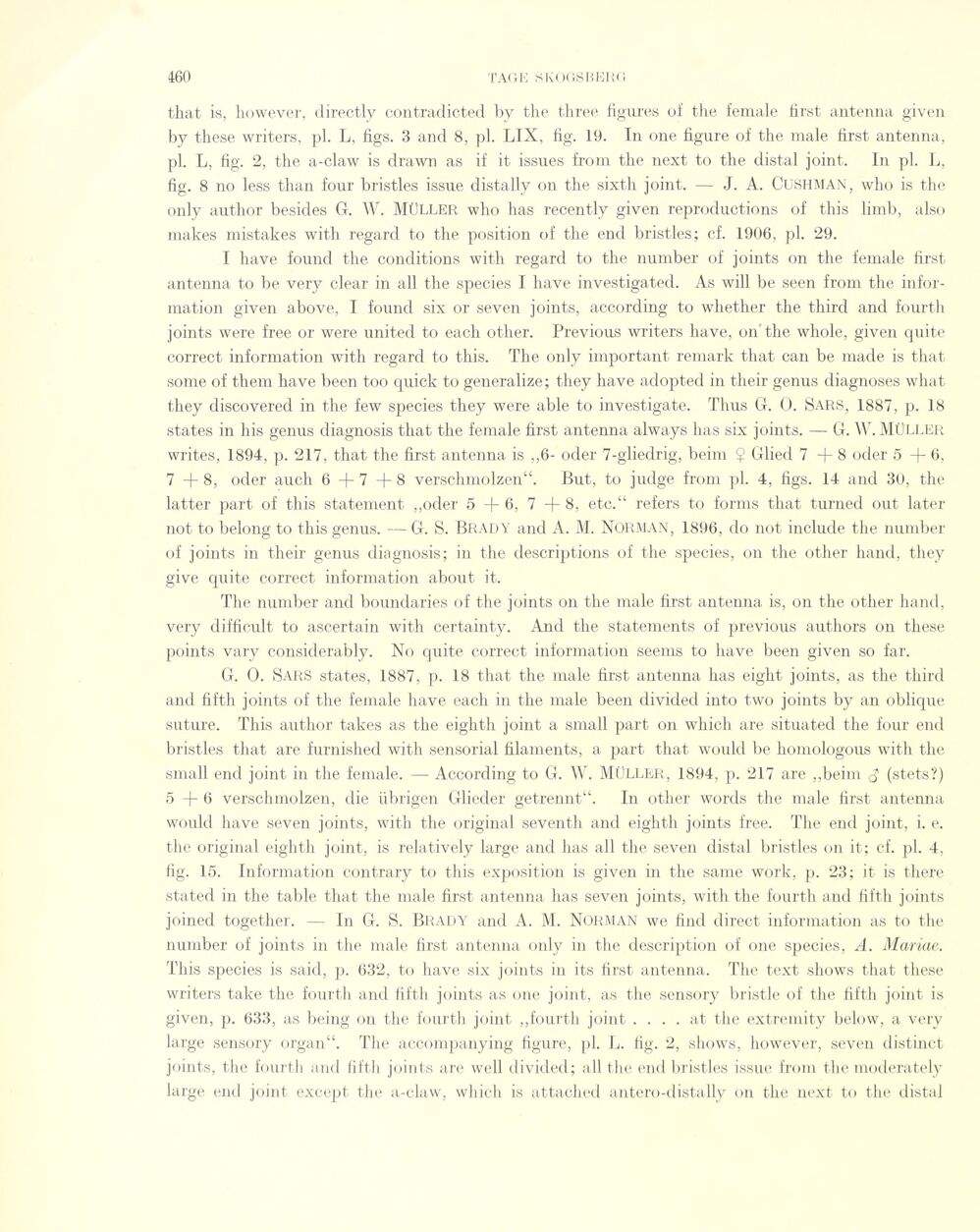
Full resolution (JPEG) - On this page / på denna sida - Sidor ...

<< prev. page << föreg. sida << >> nästa sida >> next page >>
Below is the raw OCR text
from the above scanned image.
Do you see an error? Proofread the page now!
Här nedan syns maskintolkade texten från faksimilbilden ovan.
Ser du något fel? Korrekturläs sidan nu!
This page has never been proofread. / Denna sida har aldrig korrekturlästs.
that is, however, directly contradicted by the three figures of the female first antenna given
by these writers, pl. L, figs. 3 and 8, pl. LIX, fig. 19. In one figure of the male first antenna,
pl. L, fig. 2, the a-claw is drawn as if it issues from the next to the distal joint. In pl. L,
fig. 8 no less than four bristles issue distally on the sixth joint. — J. A. CUSHMAN, who is the
only author besides G. W. MÜLLER who has recently given reproductions of this limb, also
makes mistakes with regard to the position of the end bristles; cf. 1906, pl. 29.
I have fourni the conditions with regard to the number of joints on the female first
antenna to be very clear in all the species I have investigated. As will be seen from the
information given above, I found six or seven joints, according to whether the third and fourth
joints were free or were united to each other. Previous writers have, on the whole, given quite
correct information with regard to this. The only important remark that can be made is that
some of them have been too quick to generalize; they have adopted in their genus diagnoses what
they discovered in the few species they were able to investigate. Thus G. O. Sars, 1887, p. 18
states in his genus diagnosis that the female first antenna always has six joints. — G. W. Müller
writes, 1894, p. 217, that the first antenna is ,,6- oder 7-gliedrig, beim $ Glied 7+8 oder 5+6,
7+8, oder auch 6+7+8 verschmolzen“. But, to judge from pl. 4, figs. 14 and 30, the
latter part of this statement ,,oder 5+6, 7 +8, etc.“ refers to forms that turned out later
not to belong to this genus. — G. S. Brady and A. M. NORMAN, 1896, do not include the number
of joints in their genus diagnosis; in the descriptions of the species, on the other hånd, they
give quite correct information about it.
The number and boundaries of the joints on the male first antenna is, on the other hånd,
very difficult to ascertain with certainty. And the statements of previous authors on these
points vary considerably. No quite correct information seems to have been given so far.
G. O. SARS States, 1887, p. 18 that the male first antenna has eight joints, as the third
and fifth joints of the female have each in the male been divided into two joints by an oblique
suture. This author takes as the eighth joint a small part on whicli are situated the four end
bristles that are furnished with sensorial filaments, a part that would be homologous with the
small end joint in the female. —- According to G. W. MÜLLER, 1894, p. 217 are „beim (stets?)
5+6 verschmolzen, die übrigen Glieder getrennt“. In other words the male first antenna
would have se ven joints, with the original seventh and eighth joints free. The end joint, i. e.
the original eighth joint, is relatively large and has all the seven distal bristles on it; cf. pi. 4,
fig. 15. Information contrary to this exposition is given in the same work, p. 23; it is tliere
stated in the table that the male first antenna has seven joints, with the fourth and fifth joints
joined together. — In G. S. Brady and A. M. Norman we find direct information as to the
number of joints in the male first antenna only in the description of one species, A. Mariae.
This species is said, p. 632, to have six joints in its first antenna. The text shows that these
writers take the fourth and fifth joints as one joint, as the sensory bristle of the fifth joint is
given, p. 633, as being on the fourth joint „fourth joint .... at the extremity below, a very
large sensory organ“. The accompanying figure, pl. L. fig. 2, shows, however, seven distinct
joints, the fourth and fifth joints are well divided; all the end bristles issue from the moderately
large end joint except the a-claw, whicli is attached antero-distally on the next to the distal
<< prev. page << föreg. sida << >> nästa sida >> next page >>